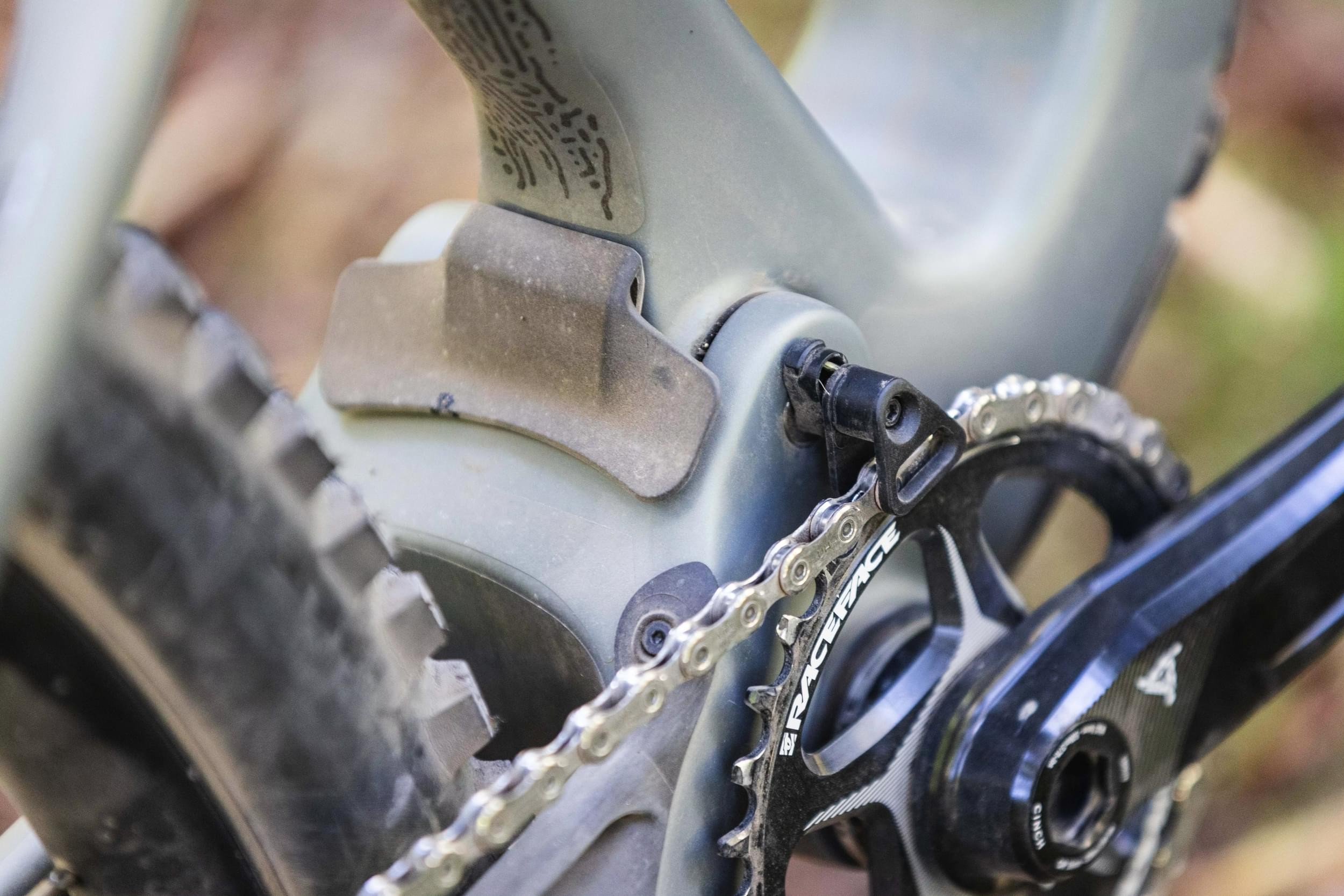Dropped chains are a cyclist’s nightmare, interrupting your flow whether you’re tackling rugged trails, cruising gravel paths, or speeding on smooth roads. Fortunately, for those embracing the simplicity of 1x drivetrains, chain guides offer a reliable solution to keep your chain securely in place. But What Does A Chain Guide Do, exactly? This guide dives into the specifics of chain guides, exploring their function, applications, benefits, and considerations for choosing the right one.
A chain guide ensures your chain stays aligned with the chainring, preventing it from derailing, especially on rough terrain.
Understanding Chain Guides
It’s crucial to distinguish a chain guide from a chain catcher (or chain keeper), often seen on road bikes with 2x cranksets. Chain guides are specifically engineered for 1x drivetrains, providing an extra layer of security to enhance chain retention beyond the capabilities of the drivetrain itself.
Applications Across Bike Types
Chain guides have evolved from bulky components primarily used on downhill and freeride bikes to sleeker, lighter versions now commonly found on a wide spectrum of mountain bikes.
Chain guides are increasingly popular on gravel bikes, providing added security for 1x drivetrains on varied terrain.
- Downhill and Enduro Bikes: Racers in these disciplines typically favor heavy-duty chain guides with top and bottom guides, often incorporating a bash guard for chainring protection.
- Trail and Downcountry Bikes: Slimmer top chain guides, like the OneUp V2, are a popular choice, offering a balance of security and weight savings.
- Gravel and Road Bikes: With the rise of 1x drivetrains in these categories, chain guide options are expanding, addressing the potential for chain drops on uneven surfaces.
While some manufacturers now include chain guides as standard equipment, they can also be easily retrofitted to existing bikes.
Advantages of Using a Chain Guide
What does a chain guide do to improve your riding experience? Here’s a breakdown of the benefits:
- Enhanced Chain Retention: Modern 1x drivetrains, featuring narrow/wide chainrings and clutch derailleurs, already offer excellent chain retention. A chain guide provides an additional safety net, virtually eliminating dropped chains.
- Improved Shifting Performance: By maintaining chain alignment, chain guides can optimize shifting, especially across challenging terrain.
- Chainring Protection: Chain guides with integrated bash guards safeguard your chainring from impacts with rocks, roots, and other trail hazards.
Chain guides are particularly useful in rough terrain, preventing chain slap and ensuring consistent performance.
Potential Drawbacks
While the advantages are clear, there are a few considerations:
- Added Weight: Chain guides do add a small amount of weight. However, with modern designs ranging from 30 to 100 grams, this is typically only a concern for weight-obsessed riders.
- Potential Rubbing: Depending on the specific chain guide and frame combination, some riders might experience slight chain rubbing in certain gears. This can often be resolved with careful adjustment, but it’s something to be aware of.
A full top and bottom chain guide with a bash plate might be excessive for some riding styles.
Chain Guides for Road and Gravel Bikes
If you’re riding a road or gravel bike with a 1x drivetrain, the question of whether to use a chain guide is relevant. While road riding typically involves smoother surfaces, unexpected bumps and potholes can still dislodge a chain.
Chain guides can be a worthwhile addition to gravel bikes, providing extra security when venturing off-road.
For gravel cyclists exploring more challenging routes, the added chain retention of a chain guide is often a worthwhile investment. Ultimately, the decision depends on your riding style and frequency of dropped chains. If you consistently experience chain issues, a chain guide is a practical solution.
Key Considerations When Buying a Chain Guide
What does a chain guide do in terms of adding complexity to your bike setup? Here are crucial factors to consider before purchasing:
Mounting Options
Chain guides utilize various mounting systems, so it’s essential to consult your frame manufacturer to determine compatibility. Common mounting options include:
- ISCG 05: Uses three tabs around the bottom bracket shell for direct mounting.
- Direct Mount: Some frames have a dedicated tab for lightweight top chain guides.
- BB Mount: The chain guide fits between the bottom bracket shell and the external bottom bracket cup.
- Seat Tube Mount: Less common on modern bikes, this involves a collar around the seat tube.
Chain Security Level
Your riding style dictates the level of chain security you require.
- Downhill/Enduro: Full top and bottom guides with bash guards are ideal for maximum chain retention.
- Trail/Enduro: A top chain guide with a bash guard offers a good balance of protection and weight.
- Trail/Downcountry: A lightweight top guide provides effective chain retention without a significant weight penalty.
Materials
Chain guides typically combine metal (for the frame or mounting surface) and durable plastic (for the guide itself). Some premium models incorporate carbon fiber for minimal weight savings.
Consider the mounting options and chain security level when choosing a chain guide for your bike.
Basic Installation Overview
Installing an ISCG or bottom-bracket mounted chain guide requires removing the cranks and potentially the driveside bottom bracket cup. Tools will vary depending on your components. ISCG-mounted guides are bolted to the ISCG tabs, while BB-mounted guides are secured by reinstalling the bottom bracket cup. Proper chainline adjustment is crucial. Direct-mount and seat-tube mounted guides are generally simpler to install.
Installing a chain guide typically involves removing the cranks and securing the guide to the frame using the appropriate mounting system.
Conclusion
What does a chain guide do? In essence, a chain guide provides invaluable peace of mind by preventing dropped chains, enhancing shifting performance, and protecting your chainring. Whether you’re a seasoned mountain biker tackling challenging terrain or a gravel rider seeking added security on unpredictable surfaces, a chain guide can significantly improve your riding experience. By carefully considering your needs and the available options, you can select the perfect chain guide to keep your chain securely in place and your ride uninterrupted.
